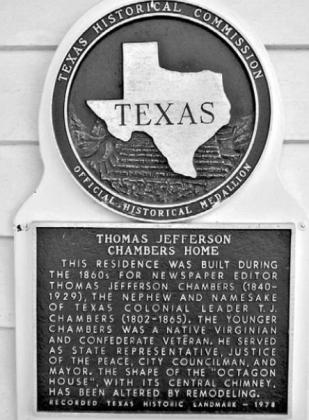Thomas Jefferson Chambers Home
Thomas Jefferson Chambers was born in Orange County, Virginia, later known as Culpepper County, on March 22nd, 1840, to Landon Gore Chambers and wife, Mary Green Allan. Chambers migrated to Liberty, Liberty County, about 1857 and became associated with H. C. Shea, publisher of The Liberty Gazette on August 2nd, 1858. By August 1859, Chambers was the sole editor of the Gazette.
The newspaper ceased operation during the Civil War when Chambers joined the First Texas Militia on the 5th of December 1861. On May 3rd, 1862, Chambers enlisted as a private in Captain E.G. Pickett’s Company, Third Regiment of the Texas Mounted Volunteers, commanded by Colonel C.C. Gillespie. He was serving at Post Arkansas in the fall of 1862 when the garrison fell to the Federal Army. He was captured on 1st January 1863 and taken to Camp Douglas in Illinois. He was later exchanged as a prisoner and participated in the siege of Chattanooga.
After the Civil War and his return home, Chambers reopened the office of The Liberty Gazette and published until 1869 when it was sold. By October 1870, Chambers became the publisher and editor of The Liberty Observer, which he operated for an undetermined length of time. In 1887, he once more became an editor and publisher of a new newspaper, The Liberty Vindicator which has been in continuous publication since that time.
During his lifetime, Chambers served the Liberty community and state in several political offices. He represented the lst District to the Texas House of Representatives from 1870-1871. He served as Justice of the Peace in Liberty County in 1888, as a member of the Liberty City Council from 1902-1903 and as Mayor from 1873-1875 and a second term from 1904-1905.
T. J. Chambers married his first wife, Mittie Smith about 1858 and had five children. His wife died in 1873 and he married secondly, Francis Nolan. They had eight children. Francis died in 1913. Thomas Jefferson Chambers died in May 1929 and is buried in the Liberty City Cemetery beside his second wife, Francis Nolan Chambers.
According to family tradition, construction of the T. J. Chambers home commenced prior to 1862 and was completed upon the return of Chambers from service with the Confederate Army during the War Between the States. Because records were destroyed in a courthouse fire, the first known date which can be verify the existence of the home is March 6, 1867, when an advertisement appeared in The Liberty Gazette. A local painting contractor, R. S. Sewill, invited prospective customers to take note of the fine example of his workmanship in the parlor of the T. J. Chambers home.
The unusually shaped home is often referred to in Liberty as the “octagon house” due to several exterior walls and porches which formed the original walls of the house suggesting the shape. Each of the original four main rooms was wedged-shaped with each containing an entrance, an exit, a triple-window, and fireplace. For the four fireplaces, there is one chimney in the center of the house extending to the roof.
At least three porches originally served the house. One faced west and is still used as the front porch entrance. Other features of the house include oversized doors, baseboards, and windows, original to the house and containing original “ripple” glass panes.
According to letters in the Julia Duncan Welder Collection in the Sam Houston Re gional Library and Research Center, the contractor/designer of this unusual-shaped home was a Mr. Dodge. He may have also designed another “unusual Y-shaped” home owned by the Bristleys during this same period, but this home was razed some years ago.
Through many years, the Chambers home has provided the focal point for many civic and social activities and a loving home for family members. Early newspaper accounts reveal an active social life centered around the homeplace. This beautiful and unusual home with unique architecture, has been passed down through the generations and currently belongs to Judge Thomas “Tommy” Chambers. It has been lovingly restored and cared for and is a reminder of the rich cultural and civic history of Liberty.

